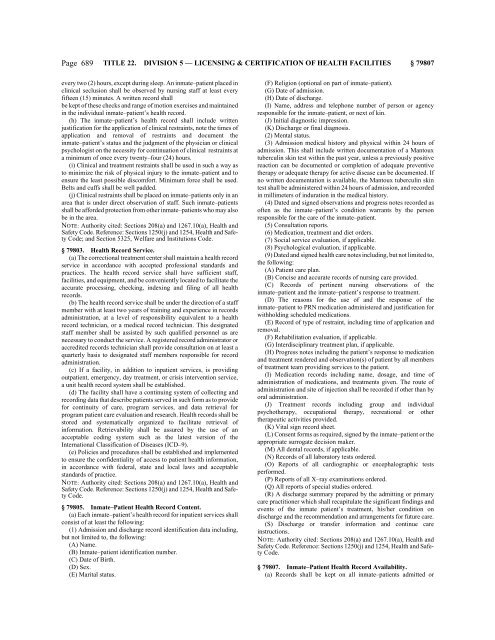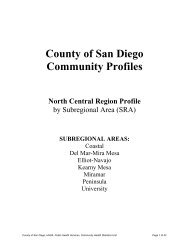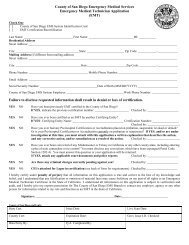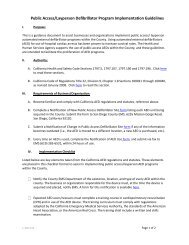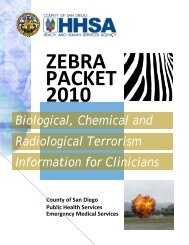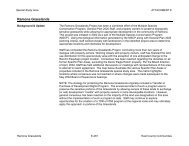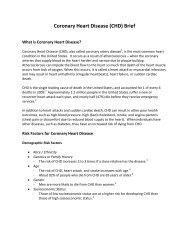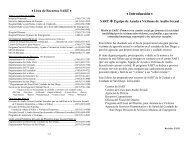CALIFORNIA CODE OF REGULATIONS - State of California
CALIFORNIA CODE OF REGULATIONS - State of California
CALIFORNIA CODE OF REGULATIONS - State of California
You also want an ePaper? Increase the reach of your titles
YUMPU automatically turns print PDFs into web optimized ePapers that Google loves.
Page 689<br />
TITLE 22. DIVISION 5 — LICENSING & CERTIFICATION <strong>OF</strong> HEALTH FACILITIES § 79807<br />
every two (2) hours, except during sleep. An inmate–patient placed in<br />
clinical seclusion shall be observed by nursing staff at least every<br />
fifteen (15) minutes. A written record shall<br />
be kept <strong>of</strong> these checks and range <strong>of</strong> motion exercises and maintained<br />
in the individual inmate–patient’s health record.<br />
(h) The inmate–patient’s health record shall include written<br />
justification for the application <strong>of</strong> clinical restraints, note the times <strong>of</strong><br />
application and removal <strong>of</strong> restraints and document the<br />
inmate–patient’s status and the judgment <strong>of</strong> the physician or clinical<br />
psychologist on the necessity for continuation <strong>of</strong> clinical restraints at<br />
a minimum <strong>of</strong> once every twenty–four (24) hours.<br />
(i) Clinical and treatment restraints shall be used in such a way as<br />
to minimize the risk <strong>of</strong> physical injury to the inmate–patient and to<br />
ensure the least possible discomfort. Minimum force shall be used.<br />
Belts and cuffs shall be well padded.<br />
(j) Clinical restraints shall be placed on inmate–patients only in an<br />
area that is under direct observation <strong>of</strong> staff. Such inmate–patients<br />
shall be afforded protection from other inmate–patients who may also<br />
be in the area.<br />
NOTE: Authority cited: Sections 208(a) and 1267.10(a), Health and<br />
Safety Code. Reference: Sections 1250(j) and 1254, Health and Safety<br />
Code; and Section 5325, Welfare and Institutions Code.<br />
§ 79803. Health Record Service.<br />
(a) The correctional treatment center shall maintain a health record<br />
service in accordance with accepted pr<strong>of</strong>essional standards and<br />
practices. The health record service shall have sufficient staff,<br />
facilities, and equipment, and be conveniently located to facilitate the<br />
accurate processing, checking, indexing and filing <strong>of</strong> all health<br />
records.<br />
(b) The health record service shall be under the direction <strong>of</strong> a staff<br />
member with at least two years <strong>of</strong> training and experience in records<br />
administration, at a level <strong>of</strong> responsibility equivalent to a health<br />
record technician, or a medical record technician. This designated<br />
staff member shall be assisted by such qualified personnel as are<br />
necessary to conduct the service. A registered record administrator or<br />
accredited records technician shall provide consultation on at least a<br />
quarterly basis to designated staff members responsible for record<br />
administration.<br />
(c) If a facility, in addition to inpatient services, is providing<br />
outpatient, emergency, day treatment, or crisis intervention service,<br />
a unit health record system shall be established.<br />
(d) The facility shall have a continuing system <strong>of</strong> collecting and<br />
recording data that describe patients served in such form as to provide<br />
for continuity <strong>of</strong> care, program services, and data retrieval for<br />
program patient care evaluation and research. Health records shall be<br />
stored and systematically organized to facilitate retrieval <strong>of</strong><br />
information. Retrievability shall be assured by the use <strong>of</strong> an<br />
acceptable coding system such as the latest version <strong>of</strong> the<br />
International Classification <strong>of</strong> Diseases (ICD–9).<br />
(e) Policies and procedures shall be established and implemented<br />
to ensure the confidentiality <strong>of</strong> access to patient health information,<br />
in accordance with federal, state and local laws and acceptable<br />
standards <strong>of</strong> practice.<br />
NOTE: Authority cited: Sections 208(a) and 1267.10(a), Health and<br />
Safety Code. Reference: Sections 1250(j) and 1254, Health and Safety<br />
Code.<br />
§ 79805. Inmate–Patient Health Record Content.<br />
(a) Each inmate–patient’s health record for inpatient services shall<br />
consist <strong>of</strong> at least the following:<br />
(1) Admission and discharge record identification data including,<br />
but not limited to, the following:<br />
(A) Name.<br />
(B) Inmate–patient identification number.<br />
(C) Date <strong>of</strong> Birth.<br />
(D) Sex.<br />
(E) Marital status.<br />
(F) Religion (optional on part <strong>of</strong> inmate–patient).<br />
(G) Date <strong>of</strong> admission.<br />
(H) Date <strong>of</strong> discharge.<br />
(I) Name, address and telephone number <strong>of</strong> person or agency<br />
responsible for the inmate–patient, or next <strong>of</strong> kin.<br />
(J) Initial diagnostic impression.<br />
(K) Discharge or final diagnosis.<br />
(2) Mental status.<br />
(3) Admission medical history and physical within 24 hours <strong>of</strong><br />
admission. This shall include written documentation <strong>of</strong> a Mantoux<br />
tuberculin skin test within the past year, unless a previously positive<br />
reaction can be documented or completion <strong>of</strong> adequate preventive<br />
therapy or adequate therapy for active disease can be documented. If<br />
no written documentation is available, the Mantoux tuberculin skin<br />
test shall be administered within 24 hours <strong>of</strong> admission, and recorded<br />
in millimeters <strong>of</strong> induration in the medical history.<br />
(4) Dated and signed observations and progress notes recorded as<br />
<strong>of</strong>ten as the inmate–patient’s condition warrants by the person<br />
responsible for the care <strong>of</strong> the inmate–patient.<br />
(5) Consultation reports.<br />
(6) Medication, treatment and diet orders.<br />
(7) Social service evaluation, if applicable.<br />
(8) Psychological evaluation, if applicable.<br />
(9) Dated and signed health care notes including, but not limited to,<br />
the following:<br />
(A) Patient care plan.<br />
(B) Concise and accurate records <strong>of</strong> nursing care provided.<br />
(C) Records <strong>of</strong> pertinent nursing observations <strong>of</strong> the<br />
inmate–patient and the inmate–patient’s response to treatment.<br />
(D) The reasons for the use <strong>of</strong> and the response <strong>of</strong> the<br />
inmate–patient to PRN medication administered and justification for<br />
withholding scheduled medications.<br />
(E) Record <strong>of</strong> type <strong>of</strong> restraint, including time <strong>of</strong> application and<br />
removal.<br />
(F) Rehabilitation evaluation, if applicable.<br />
(G) Interdisciplinary treatment plan, if applicable.<br />
(H) Progress notes including the patient’s response to medication<br />
and treatment rendered and observation(s) <strong>of</strong> patient by all members<br />
<strong>of</strong> treatment team providing services to the patient.<br />
(I) Medication records including name, dosage, and time <strong>of</strong><br />
administration <strong>of</strong> medications, and treatments given. The route <strong>of</strong><br />
administration and site <strong>of</strong> injection shall be recorded if other than by<br />
oral administration.<br />
(J) Treatment records including group and individual<br />
psychotherapy, occupational therapy, recreational or other<br />
therapeutic activities provided.<br />
(K) Vital sign record sheet.<br />
(L) Consent forms as required, signed by the inmate–patient or the<br />
appropriate surrogate decision maker.<br />
(M) All dental records, if applicable.<br />
(N) Records <strong>of</strong> all laboratory tests ordered.<br />
(O) Reports <strong>of</strong> all cardiographic or encephalographic tests<br />
performed.<br />
(P) Reports <strong>of</strong> all X–ray examinations ordered.<br />
(Q) All reports <strong>of</strong> special studies ordered.<br />
(R) A discharge summary prepared by the admitting or primary<br />
care practitioner which shall recapitulate the significant findings and<br />
events <strong>of</strong> the inmate patient’s treatment, his/her condition on<br />
discharge and the recommendation and arrangements for future care.<br />
(S) Discharge or transfer information and continue care<br />
instructions.<br />
NOTE: Authority cited: Sections 208(a) and 1267.10(a), Health and<br />
Safety Code. Reference: Sections 1250(j) and 1254, Health and Safety<br />
Code.<br />
§ 79807. Inmate–Patient Health Record Availability.<br />
(a) Records shall be kept on all inmate–patients admitted or


